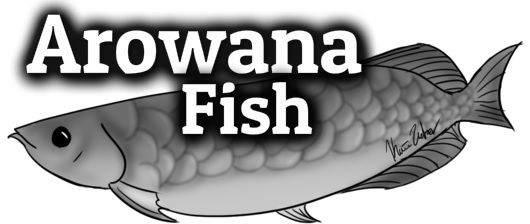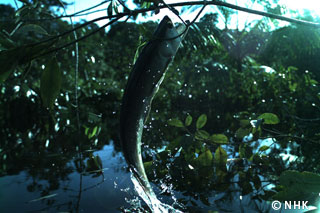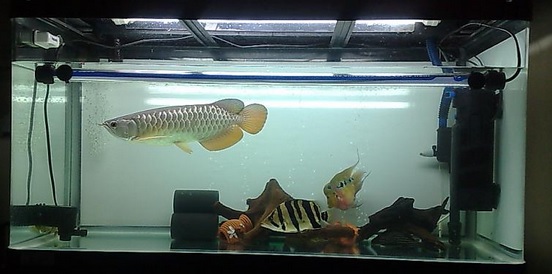
The Arowana is a super popular fish amongst the fish aquarium community because of it’s “prehistoric” cosmetic appearance. It is considered an exotic species when compared to the average fish pet stores are selling to aquarists. What also adds popularity to keeping Arowanas in fish aquariums is their ravenous carnivore eating habits.
Viral videos are surfacing the internet containing Arowana fish feeding on live rabbits, small birds, rats, and more. Advanced marine specialists refer to it as “bad publicity”. Horrific feedings of Arowanas jumping out of the water to catch their pray shouldn’t be publicized in this manner. Interesting enough, some countries have made it illegal to record videos of aggressive feedings just for this reason.
Sometimes referred to as “Aros” in the industry, these fish are heavy carnivores. During their juvenile growth, fill their diet with lots of heavy protein meaty foods like brine shrimps, small feeder fish, worms, and insects. There are lots of foods that Arowanas feed on in their natural habitat, if it involves meat than this heavy carnivore is going to attack with force. With the brutal speed of this fish’s attack, not too many animals get away freely.
** Are you only interested in keeping Arowanas in aquariums? Click here
Natural Habitat & Lifestyle
Most species of Arowanas are home to the flood plains of South America. These fish are maybe one of the most unique looking fish of the freshwater habitat. It’s not uncommon for them to grow up to 46 inches long in their natural habitat. The flood plains of South America can contain very shallow water depths and the Arowana can actually survive out of the water for some time. It’s unique swim bladder allows it to still breath completely out of the water while possibly moving to a different body of water.
Aros are found naturally in white and black water floodplains of South America in the freshwaters of the Amazon River Basin and River, maybe in the Rupununi and Oyapock Rivers, and in some still waters of Guyana as well.
 What is mind blowing about this fish is the fact that they have been seen jumping as far as 6 feet into the air for their prey. If you have seen how fast they strike the water surface to indulge their prey.. you can imagine how scary they look shooting out of the water to strike their next meal. Not to mention how scary they already look. They are commonly referred to as “prehistoric looking” and I agree.
What is mind blowing about this fish is the fact that they have been seen jumping as far as 6 feet into the air for their prey. If you have seen how fast they strike the water surface to indulge their prey.. you can imagine how scary they look shooting out of the water to strike their next meal. Not to mention how scary they already look. They are commonly referred to as “prehistoric looking” and I agree.
Different Species & Types
Some of the species of Aros that are available have been manipulated by man to produce new species. Some types are so rare that they are costing hundreds of thousands of dollars to have these as pets in fish aquariums. Breeders are always on the lookout for rare breeds just for the mere fact of breeding them to make more money with selling their babies. Click here to view an article on all the species and types.
Pet Arowanas in Fish Aquariums
They are commonly hanging around the top of fish aquariums waiting to strike. In natural lifestyle, Aros jump out of the water to catch insects hanging on low hanging trees. It’s an incredible site to see but a nightmare for fish aquarium owners. Nobody wants their exotic pet fish jumping out of the tank and laying on the floor. Keep tops over your tanks for safety (refer to tank setup portion).
*Note: Remember that different species are going to be different in cost. Some are very rare and exotic. Some of the more common species are the Silver and Red Aro.
 When setting up your aquarium for an Arowana, you will need good filtration. These fish are very messy because of their strong eating habits. Keep a close eye on your water parameters because the can change very fast with this style of a fish. Have a scheduled time every week in which you do water changes.
When setting up your aquarium for an Arowana, you will need good filtration. These fish are very messy because of their strong eating habits. Keep a close eye on your water parameters because the can change very fast with this style of a fish. Have a scheduled time every week in which you do water changes.
Figure out what percent works good for your tank and how often to do them. Most fish keepers that own “Aros” already know these basics because this fish is more of an intermediate level aquarium fish. It’s good to educate new hobbyists on what needs to happen to keep clean water parameters though. Also note that these fish take lots of foods rich in protein and that will also effect your clean water when they attach the food.
Price to Buy Arowana for a Pet
Depending on what species of Arowana you desire to have as a pet will determine how much it is going to cost you. Because some species are on the endangered species list, the cost is going to be extremely high if not even illegal to have as a pet. For more common species of Arowanas, the prices are going to very from $50 to a couple hundred dollars per fish. What usually makes these more common species more expensive is size of the fish. Fish keepers desire a larger fish because they are more beautiful and it takes a long time to get to a large size growth.
Size of Fish Aquarium Needed?
These fish aren’t for beginner level aquarium owners. When fish grow to be as large as Aros do, you need very large fish aquariums. I would advise nothing smaller than 100 gallons of aquarium space. You may be able to get away with a smaller aquarium when the fish is in juvenile state, but they do grow at a rapid pace and it’s almost not even worth your time. Most Aro enthusiasts have 125 gallon aquariums and larger.
If your new to the hobby, you will quickly find that keeping pet fish like this is very expensive. A 125 gallon aquarium can commonly cost around $500 U.S. dollars. So to say the least, keeping these fish is a very serious setup. Most beginners are turned down when they research what it takes in cost just to keep these fish.
Have Anything to Add?
Posted by Nathan: Does anyone feed their pet aro BEEFHEART?? I have heard that it makes them grow very fast and is full of meaty protein.
@Reply: The issue with beefheart is that it’s a terrestrial protein that most fish find difficult to digest. It’s extremely fatty and can cause massive internal problems with lipid build up over vital organs.
@Reply: Have to be very careful when making beefheart for the fish, need to remove all the veins and really mix it well in a blender, along with the vitamins and such.
@Reply: Depends on the fish you are feeding it too, what you will put in it.. there are different recipes that are aimed for fish like discus, bettas and so forth. I have a silver species die on me from not feeding it correctly.
@Reply: lasts two weeks in the fridge and can put it in the freezer for a couple months as well, just thaw and serve. Love the stuff. I’ve never used beefheart – some people swear by it, others don’t want to take the risk. So I either make my own food (using different white fish and add a bit of spinach and garlic and mash together) or repashy if I don’t want to feed pellets/flakes.
@Reply: beefheart is an excellent source of protein. Very rich, low fat and high in iron. If you are a lion, or wolf, or tiger, or gila monster. For fish, stick to fish proteins, like shrimp, krill, salmon, etc or other awesome fish digestive friendly proteins like daphnia, brine shrimp, tubiflex worms, bloodworms, etc. Must sounder to digest than the more complex protein found in beef heart. Not to mention since it clouds in your water, the bacteria that this promotes in your quality of water… too many “beef heart” fed Cichlids have come through my hands with hole in the head and or lateral line erosion. I wouldnt consider many terrestrial meats appropriate for fish. That is my personal take on it though.
@Reply: You need a good filtration system to keep the water quality optimum, be careful not to overfed with beefheart, my red arowana was overfed and died from that, since then, i’m careful with beefheart.
Posted by Jason: Does anyone keep their fish with tiger oscar species?
Posted by Alisha R: Why is it that people who have huge tanks need to heavily overstock it? I mean, imagine a 1000 gallon tank wich is big. But for some reason, people need to put in there 3 arowanas, 2 peacock bass. 3 oscars. 2 Florida gars 1 red tail catfish and the leftover goldfishs that are used to feed them because your to lazy to make them eat pellets. Wouldn’t it be better to have 1 big fish and groups of smaller fish. I would put in there a school of silver dollars and anything that would go well with them.
@Reply: Not everyone has the same taste in fish community. And feeding live food is less lazy than just throwing in some prepackaged pellets with no thought of choosing quality safe live food to stimulate the fishes natural hunting instincts.
@Reply: Not what I meant. But good point. The thing is in some places live feeding is illegal. And why feed goldfish wich can kill your fish when you can breed fish yourself and avoid any diseases because you know where the food comes from. In that term I meant lazy.
@Reply: And I don’t mean to start another Debate but isn’t the fish Hobby we all so much enjoy all about personal preference?…. No I’m not saying throw 3 Oscars with 3 red tails and let them have at it… However it’s their own tank and I believe they pay to maintain it accordingly. So I highly doubt that gives you the power to Oder which fish goes where.
@Reply: I’m not saying I’m going to tell them that they can’t do that. They can do whatever the hell they want. But, it’s my personal preference to have a centerpiece fish wich would be the big boss. And other smaller fish that would not cause such a huge biolad.
@Reply: If you have a tank that is “overstocked” but the fish are absolutely thriving, very healthy, reproducing with little effort and not stressed, all the while maintaining the tank the best you can and all parameters are perfect, then what?
@Reply: What I think is impressive is having different tanks with different fish, community planted with schools if tetras and big fish with school of white clouds. Don’t overstock unless you are willing to put in the effort! Overstocked african tank is impressive though.
@Reply: overstocking large predators keeps the aggression down, feeding goldfish causes thiaminase deficiency and shortens life spans, feeding natural minnows is best. putting a large predator with a bunch of smaller fish is asking for disaster. dither fish only work with certain species.
my personal preference is to have large groups of cohabbing small specie fish in giant tanks, if the stores 2k tank inhabintants passed i was going to fill it with community fish lol
@Reply: it will be a disaster if said “hobbist” is uneducated. What is overstocking? If you can handle the bioload how can it be overstocked? Just on looks because biological isnt an issue? Id say it all depends on the species. You can jam alot of small fish into a large tank but due to tanks size the bioload wont be a factor. I can only speak for myself but i know for a fact i am barely feeding the filters with my stock of fish ( 210g with 50g sump,uv,5 discus 5 bnps 2 clown plecos a banjo half a dozen corydoras an oto 3 dozen buenos aires and a half dozen mix of black neons amd reb and blue tetras. Its all in self discipline and education.
@Reply: Education is good but when it comes to holding someones hand and making them run their tank like what someone else feels best is too far.
If I had listened to everyone that had told me I couldnt do something Id have never done anything. Experimenting and learning from your own experience can teach a lot. Not that you cant learn from others mistakes as well.
People are going to do waht they want to do.
Posted by Eric L: I have a separate now spare tank I want to use for feeders but how do I breed them so i don’t have to keep purchasing…Maybe minnows or small gold fish…I have an arowana and getting a few more in different tanks…. As well as huge chichlids… Thanks in advance!
Posted by Haley R: Looking for a CO2 diffusor for a 450 gallon tank. Anyone have any ideas what to use? The new tank should be here in a month or so and want to get things ready for it. It also needs to be break proof as the tank is housing a now 28 inch arowana and 2 9-10 inch Pangasius catfish.